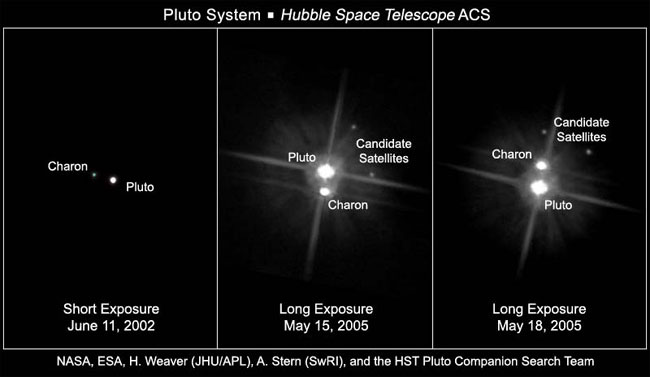Two More Moons Discovered Orbiting Pluto

Two small moons have been discovered orbiting Pluto, bringingthe planet's retinue of known satellites to three and leaving scientist towonder how it could be.
The newfoundmoons orbit about 27,000 miles (44,000 kilometers) from Pluto, more thantwice as far as Charon, Pluto's other satellite. They are 5,000 times dimmerthan Charon.
Preliminary observations suggest they are in circular orbitsaround Pluto and in the same plane as Charon, said Hal Weaver of the JohnsHopkins Applied Physics Laboratory.
"That suggests they probably formed at the same time asCharon," Weaver told SPACE.com in a telephone interview Friday.NASA planned a teleconference with reporters Monday at 1 p.m. ET to announcethe discovery.
While scientists had predicted there might be more moons, thenewfound setup is surprising nonetheless, in part because Pluto is smaller thanour own Moon.
"It's almost like a mini solar system," Weaver said."How can something about 70 percent the size of Earth's Moon have allthese satellites? How can that happen? We're going to have to explainthat."
The leading theory for the formation of Charon involves a largeobject strikingPluto. The debris from that collision could have formed the two smallermoons, Weaver speculates. It can't be ruled out that they might have beencaptured into the system, but that seems very unlikely, he said.
Get the Space.com Newsletter
Breaking space news, the latest updates on rocket launches, skywatching events and more!
The twonew moons are between 30 and 100 miles (45 to 160 kilometers) in diameter,Weaver said. There is not enough data to pin their size down exactly, however.Pluto is 1,430 miles wide and Charon's diameter is about 730 miles.
The moons were found using the Hubble Space Telescope.
Piece of the puzzle
The discovery represents one more piece of an increasinglycomplex puzzle in the outer solar system, a place that astronomers look to forclues in understanding how it all formed 4.5 billion years ago in the wake ofthe Sun's birth.
Lately, so many objects have been found in so manyconfigurations out there, that astronomers can'teven agree on what to call them.
Though popularly considered a planet, Pluto is now viewed bymost astronomers to be a member of the Kuiper Belt, a vast sea of frozen worldsbeyond Neptune that hadn't been discovered when Pluto was found 75years ago. The region includes other roundobjectswithmoons, and one recently discovered world is larger thanPluto.
For now, Pluto is the only Kuiper Belt object known to havemore than one companion.
"Our result suggests that other bodies in the Kuiper Beltmay have more than one moon as well," said team co-leader Alan Stern ofthe Southwest Research Institute in Boulder, Colo.
Stern heads up the NewHorizons mission to Pluto and the Kuiper Belt, slated for launch early nextyear. He had longpredicted other moons around Pluto.
There could be more moons to find, too, but they would besmall.
"These Hubble images represent the most sensitive search yetfor objects around Pluto," said team member Andrew Steffl of the SouthwestResearch Institute, "and it is unlikely that there are any other moonslarger than about 10
miles across in the Pluto system."
Easy to find
The moon-hunting project was denied by Hubble planners severaltimes and took years to get approved, and only then after a failed instrumenton Hubble last year caused project leaders to add several previously unacceptedobserving programs to fill the schedule.
For Hubble, this one was easy.
Unlike many observing projects that require several Hubbleorbits – often 15 or more and sometimes many dozens -- Weaver's team neededjust two orbits. On the first set of observations they spotted the two pointsof light, then on the second orbit they found them again and made sure theymoved against the background of relatively fixed stars.
The presumed moons are 23rd magnitude, far to dim to be seenwith a typical backyard telescope but "relatively easy to see withHubble," Weaver said.
Then the astronomers dug up old Hubble observations done bycolleague Marc Buie of the Lowell Observatory, to see if the same objects hadbeen imaged before.
Weaver said they are pretty sure they've located the moons inthe archived photos, and the combination of data is what suggests the moons'circular orbits in the plane of Charon's path.
More Hubble observations are planned for February to confirmthe discoveries and pin down the orbits.
The moons are catalogued as S/2005 P1 and S/2005 P2 for now.Once they are confirmed, the discoverers will suggest names, to be approved bythe International Astronomical Union.
- Defining 'Planet': Newfound World Forces Action
- Tally of Asteroids Harboring Moons Grows Beyond 30
- Global Warming on Pluto Puzzles Scientists
Join our Space Forums to keep talking space on the latest missions, night sky and more! And if you have a news tip, correction or comment, let us know at: community@space.com.

Rob has been producing internet content since the mid-1990s. He was a writer, editor and Director of Site Operations at Space.com starting in 1999. He served as Managing Editor of LiveScience since its launch in 2004. He then oversaw news operations for the Space.com's then-parent company TechMediaNetwork's growing suite of technology, science and business news sites. Prior to joining the company, Rob was an editor at The Star-Ledger in New Jersey. He has a journalism degree from Humboldt State University in California, is an author and also writes for Medium.









